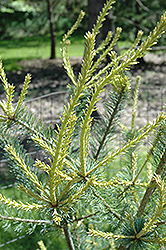It's all about ...
plants

Azuma No Iwai Japanese White Pine
Pinus parviflora 'Azuma No Iwai'
Height: 6 feet
Spread: 4 feet
Sunlight:
![]()
Hardiness Zone: 5a
Description:
This attractive variety with its irregular open and airy form contributes an Asian aesthetic to the garden; a great choice for rock gardens, troughs, and small landscapes; new growth of yellow stems and needles adds spring interest
Ornamental Features
Azuma No Iwai Japanese White Pine is a dwarf conifer which is primarily valued in the landscape or garden for its ornamental upright and spreading habit of growth. It has attractive bluish-green evergreen foliage which emerges yellow in spring. The tiny needles are highly ornamental and remain bluish-green throughout the winter.
Landscape Attributes
Azuma No Iwai Japanese White Pine is an open multi-stemmed evergreen shrub with an upright spreading habit of growth. Its relatively fine texture sets it apart from other landscape plants with less refined foliage.
This is a relatively low maintenance shrub. When pruning is necessary, it is recommended to only trim back the new growth of the current season, other than to remove any dieback. It has no significant negative characteristics.
Azuma No Iwai Japanese White Pine is recommended for the following landscape applications;
- Accent
- Mass Planting
- Hedges/Screening
- General Garden Use
Planting & Growing
Azuma No Iwai Japanese White Pine will grow to be about 6 feet tall at maturity, with a spread of 4 feet. It tends to fill out right to the ground and therefore doesn't necessarily require facer plants in front, and is suitable for planting under power lines. It grows at a slow rate, and under ideal conditions can be expected to live for 60 years or more.
This shrub should only be grown in full sunlight. It prefers dry to average moisture levels with very well-drained soil, and will often die in standing water. It is considered to be drought-tolerant, and thus makes an ideal choice for xeriscaping or the moisture-conserving landscape. It is not particular as to soil type or pH, and is able to handle environmental salt. It is somewhat tolerant of urban pollution. This is a selected variety of a species not originally from North America.
This plant is not reliably hardy in our region, and certain restrictions may apply; contact the store for more information.
